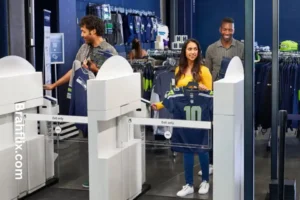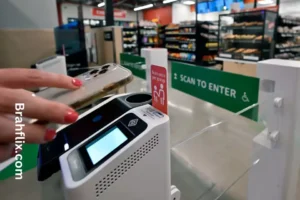Introduction
In a surprising turn of events, Amazon Ditches Walk Out Grocery Stores. These stores, known for their innovative use of technology to streamline shopping experiences, represented a significant shift in how consumers approach grocery shopping. This article delves into the reasons behind Amazon’s decision, the impact on the grocery retail sector, and what it means for consumers and competitors alike.
Key Takeaways
- Amazon’s shift reflects broader changes in consumer behavior and retail technology.
- The walk-out model aimed to revolutionize grocery shopping but faced challenges.
- Competitors are adapting to capitalize on Amazon’s retreat.
- Understanding this shift provides insights into the future of grocery retail.
The Rise of Amazon Walk-Out Grocery Stores
Amazon first introduced its walk-out grocery stores with the ambition of revolutionizing the shopping experience. The concept was straightforward: customers could simply grab items and walk out without waiting in line or going through a traditional checkout process. This was made possible through advanced technology that tracked purchases via smartphone apps and sensors.
The allure of such convenience drew many shoppers, leading to high expectations for the model. However, it was not without challenges. The technology needed to operate these stores required constant updates and maintenance, leading to operational complexities that may have contributed to Amazon’s decision to shift strategy.
Reasons for Abandoning the Walk-Out Model
Several factors prompted Amazon to ditch the walk-out grocery stores:

Operational Challenges
The implementation of the walk-out technology was fraught with difficulties. Issues with the accuracy of inventory tracking and the management of customer flows complicated the shopping experience. Technical glitches not only frustrated customers but also hindered operational efficiency.
Consumer Preferences
While some shoppers were intrigued by the technology, many preferred the traditional shopping experience. The lack of human interaction and the inability to physically examine products before purchase deterred a significant portion of Amazon’s target demographic.
Competitive Landscape
As competitors like Walmart and Kroger adapted their strategies to offer online and in-store solutions, Amazon found itself in a more competitive environment. The grocery market is notoriously difficult to navigate, and other retailers capitalized on Amazon’s technological challenges to gain market share.
The Impact on the Grocery Retail Sector
The decision to abandon the walk-out stores has significant implications for the grocery retail sector. It may signal a broader trend toward hybrid shopping models that combine technology with traditional retail elements.
Opportunities for Competitors
With Amazon stepping back, competitors have an opportunity to fill the gap. Retailers can enhance their own technological solutions to attract customers looking for convenience without sacrificing the shopping experience.
Emphasis on Customer Experience
As the market evolves, there will likely be a greater emphasis on customer experience. Retailers may invest in enhancing in-store experiences and developing robust online platforms that cater to diverse shopping preferences.
What Lies Ahead for Amazon
Amazon’s retreat from walk-out grocery stores does not mean the end of its grocery ambitions. Instead, it reflects a strategic pivot towards more sustainable models that leverage both technology and human interaction.
Focus on Online Grocery Delivery
Amazon has already established itself as a leader in online grocery delivery. By prioritizing this avenue, the company can streamline operations and better meet consumer needs without the overhead of physical stores.
Potential for New Innovations
The abandonment of walk-out stores may pave the way for new innovations. Amazon’s extensive resources and technological expertise can be redirected towards more promising projects that enhance the customer experience in other ways.
The Role of Technology in Modern Grocery Shopping
Despite the challenges associated with walk-out grocery stores, the role of technology in grocery shopping is undeniable. Innovations such as smart carts, online shopping apps, and AI-powered inventory systems are changing how consumers shop.
The Rise of Smart Technology
Smart technology is making grocery shopping more efficient. Consumers now have access to apps that provide real-time inventory updates, price comparisons, and personalized shopping experiences.
Integration of AI and Machine Learning
AI and machine learning play crucial roles in inventory management and customer service. Retailers that embrace these technologies can enhance operational efficiency and improve the overall shopping experience.
Consumer Behavior in the Digital Age

The digital age has fundamentally changed consumer behavior. Shoppers today expect convenience, speed, and personalization.
Convenience is Key
Consumers increasingly prioritize convenience. The walk-out model aimed to meet this demand, but its failure illustrates that convenience must be balanced with a positive shopping experience.
The Importance of Personalization
Personalization has become a vital aspect of retail. Consumers appreciate tailored experiences, and retailers must adapt to provide options that cater to individual preferences.
Lessons from Amazon’s Walk-Out Grocery Stores
Amazon’s experience with walk-out grocery stores offers valuable lessons for the retail industry.
Embrace Flexibility
Retailers should remain flexible and responsive to consumer feedback. This adaptability is crucial in a rapidly changing market.
Invest in Technology Wisely
Investing in technology should be balanced with an understanding of consumer needs. Retailers must ensure that technology enhances the shopping experience rather than complicates it.
The Future of Grocery Retail
As Amazon moves away from the walk-out model, the grocery retail landscape is poised for evolution.
The Rise of Hybrid Models
Hybrid shopping models that integrate online and in-store experiences will likely dominate the market. Retailers will need to offer seamless transitions between platforms to meet consumer expectations.
Sustainability and Health Consciousness
Sustainability and health consciousness are shaping grocery shopping. Retailers must adapt their offerings to cater to the increasing demand for organic, sustainable products.
FAQs
Why did Amazon abandon walk-out grocery stores?
Amazon faced operational challenges and shifting consumer preferences, prompting the company to refocus its grocery strategy.
What are the implications for grocery retailers?
Retailers can capitalize on Amazon’s retreat by enhancing their own technological solutions and focusing on customer experience.
How will this affect consumers?
Consumers may benefit from a more competitive grocery market that prioritizes convenience and personalization.
What technologies are shaping grocery retail?
Technologies such as AI, machine learning, and smart carts are transforming the grocery shopping experience.
What does the future hold for grocery retail?
The industry is likely to see a rise in hybrid shopping models, emphasizing the importance of both technology and traditional retail elements.
Conclusion
Amazon’s decision to ditch walk-out grocery stores marks a pivotal moment in the retail landscape. As the company pivots toward more sustainable strategies, the implications for competitors and consumers are significant. This shift highlights the importance of balancing technology with a positive shopping experience and the need for retailers to remain adaptable in a dynamic market.
What are your thoughts on Amazon’s strategy? How do you think the grocery retail landscape will evolve? Check out our other blogs for more insights into the future of shopping and technology!